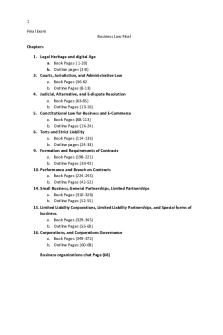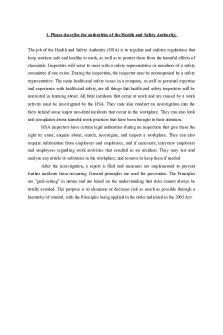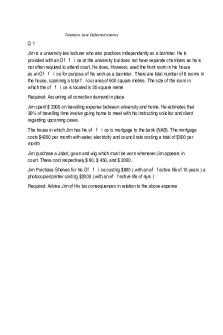Taxation LAW Final EXAM PDF

| Title | Taxation LAW Final EXAM |
|---|---|
| Course | Taxation Law |
| Institution | University of Technology Sydney |
| Pages | 8 |
| File Size | 189.7 KB |
| File Type | |
| Total Downloads | 35 |
| Total Views | 163 |
Summary
my final exam answers, grade: Distinction...
Description
Question 1 (25 Marks) Is Omega subject to tax deductions on the instalment of the air-conditioning in the commercial premises? Under s25-10 ITAA97, expenditure incurred for repairs to premises or part of a premises used solely for the purpose of producing income is deductible. In this case, Omega has not undergone a repair of any sort, and has purchased and installed a new air-conditioning system into their owned commercial premises. Thus, under s25-10 ITAA97, the $25,000 spent on the instalment is not tax deductible. However, under s40-25(1) Division 40 Uniform Capital allowances, an entity can deduct an amount equal to the ‘decline in value’ for an income year of a “depreciating asset” held during the year. The air-conditioning is stated to last 14 years, and thus Omega can calculate the deduction for decline in value using the Prime cost method under s40-75 ITAA97. The deduction for decline in value for the air-conditioning is ($25,000 x 365/365 x 100%/14 years = $1785.7). Therefore, the decline in value of $1785.7 is tax deductible for Omega.
What type of partnership is Omega involved in and what is the allocation of the partnership losses or net income of the partnership?
Ordinarily, under s995-1 ITAA97, there are three types of partnerships, these being General law, Tax law or a Limited partnership. General law partnership is where two or more persons carry on a business in common with a view to profit whereas Tax Law Partnerships are where two or more persons are in receipt of ordinary income jointly as seen in the FCT v McDonald case. In this case, Omega has 50% interest in the partnership and thus jointly owns the business with the unrelated party. This is a tax law partnership and therefore, all allocations are made according to each partner’s ownership interest and the parties are not able to freely choose their own allocations. Therefore, the tax loss made from the income year 2019/20 of $60,000 will be allocated as 50/50 between the two partners. Omega is allocated ($140,000 $60,000 x 50% = $40,000) $40,000 of the partnership loss.
Can Omega claim a tax deduction on the advertising expense incurred in the 2019/20 income year?
Generally, under s40-880(3), businesses can claim tax deductions on general operating expenses in the year they incurred them and if it is for a taxable purpose. These operating expenses can include wages, legal expenses, public relations, bad debts, and advertising and sponsorship. Since Omega is carrying on a business for tax purposes, the advertising expense of $150,000 incurred for the year 2019/20 can be tax deductible as this increase in advertising expense was for the purpose of retaining market share against its competitors.
Is the $8000 stolen by Jim considered assessable income? Under Parson’s Proposition 5, for an amount to be considered income, the taxpayer must be beneficially entitled to the amount otherwise there is no gain. As seen in the case Zobory v FCT, the employee had stolen money and there was a breach of trust with the employer. In this case, the $8000 Jim stole cannot be considered assessable income because he was not beneficially entitled to the money.
Can Omega claim a tax deduction on the $2,700 incurred for legal advice on fairly dismissing an employee and can they deduct a loss on the stolen money?
Generally, under s8-1 ITAA97, the taxpayer can deduct all losses and outgoing incurred in income-producing activities or where necessarily incurred in carrying on a business. As seen in the case of Snowden & Wilson v FCT, expenses incurred in defending the business for continued operation are deductible. In this case, Omega sought legal advice to appropriately dismiss Jim for his misconduct to the business, which cost Omega a loss of $8000, to avoid any wrongful dismissal action from him and incurred $2,700 in fees for the advice. Since the legal advice was sought to avoid any further complications with Jim and to cease the misconduct of stealing money that interrupted the assessable income of the business, Omega can claim a tax deduction on the $2,700 incurred. Further, under s25-45 ITAA97, Omega can deduct a loss in respect of the money as it falls under one of the categories of the method of loss. This being theft and stealing. It can also be deducted as the money lost was included in their assessable income for the income year.
What is the maximum franking credit for the distribution for Omega?
Under s202-60, Maximum franking credit = $28,000 (amount of distribution) x1 / 2.33 (corporate gross up rate) = $12,017 Omega’s benchmark % = 60% (first dividend in franking period) s203-30
Question 2 (25 Marks) Is Katie’s work salary of $120,000 considered as assessable income?
Ordinarily, incomes consisting of salaries and wages that are a product of personal exertion is considered as assessable income under s6-5(1) ITAA36. Her salary of $120,000 from her employment as a full-time management consultant is considered as assessable income. Therefore, there is a sufficient nexus between the income she receives and her personal exertion as a full-time management consultant.
Can Katie claim deductions on her travel expenses of $3000, travelling from her home in Epping to the Sydney CBD?
It is important to distinguish between “travelling to work” and “travelling IN the course of your work”. In the Lunney v FCT case, the general principle for travel expenses is that travel expenses between work and home are generally not tax deductible under s8-1 ITAA97. It is rather considered a private expense. In this case, Katie’s travel is considered as “travel to work” only and is therefore not tax deductible as it is a private expense. Therefore, Katie cannot claim deductions on her travel expense of $3000, travelling from her home in Epping to the Sydney CBD under the second negative limb s8-1(2)(b).
Can Katie claim deductions on her travel expenses of $900, travelling from client premises to her home? Generally, travelling between a workplace and home is not tax deductible and considered a private expense under s8-1. However, tax deductions can be claimed for travel between your normal workplace to an alternative workplace such as a client’s premises whilst still on duty. In this case, however, Katie is travelling home from client premises and not from her normal workplace in the Sydney CBD. Thus, Katie cannot claim deductions on her travel expense of $900 as she is not travelling between her normal workplace and the client’s premises, but rather the Client’s premises and her home in Epping. Under s8-1, this is still considered a private expense.
Can Katie claim deductions on the clothing expenses incurred?
Under s8-1 ITAA97, the costs of purchasing ordinary conventional clothing items are generally not deductible unless it is protective work gear, compulsory uniforms registered under division 34 or occasion-specific clothing. However, there have been case law exceptions as seen in the case of FCT v Edwards where the court allowed deductions on the costs of additional clothing that was required to be worn at official business occasions. In this case, Katie had incurred clothing expenses of $1200 on designer suits to be worn to client meetings as expected by her employer. Despite the FCT v Edwards case, Katie cannot claim deductions on her clothing expenses as she was no required to purchase designer suits for work.
Can Katie claim deductions on expenses incurred for the 7-day conference in Queensland? The general principle for self-education purposes, under TR98/9, is that they are generally deductible where they are incurred to maintain or increase the taxpayer’s skill in an occupation in which the taxpayer is currently engaged. In this case, Katie had incurred a total expense of $3000 ($1500 + $1000 + $500) for the costs involved in attending the conference. The conference Katie attended was an effort to improve her prospects for promotion and encouraged by her employer, and thus the expenses incurred are tax deductible. Katie can claim deductions on the $3000 as there is a sufficient nexus between her expenses and her income-producing activities as the conference was to improve her specific skills required for her current work activities.
Can Katie claim deductions on her membership fees of $700 for the Management Consultants’ association of Australia and on the $500 subscriptions to Management Consulting Journals? Under s25-55 ITAA97, payments made for memberships of a trade, business or professional association can be deductible, however it only allows deductions up to a limited amount of $42. Alternatively, under s8-1 ITAA97, there is no limit to how much can be claimed and taxpayer’s may choose to deduct their expense under s8-1. Therefore, Katie can claim deductions on her membership fees of $700 to the association. Moreover, Katie’s subscription fee of $500 is deductible as it is related to the production of her assessable income.
How much will Katie be allocated from the relevant share of net income of the trust estate?
Under s101 ITAA36, the trustee of a discretionary trust has obsolete discretion on how much will be allocated to each beneficiary from the income of the trust estate. Before allocation, trust law income and beneficiary entitlements as a percentage must be determined as trust law is the distributable income ascertained by the trustee. In this case, Sally, the trustee, has allocated the trust law income as follows:
Katie 40% Emily 20% Bob 30% Jane 10%
The net income has been calculated under s95 ITAA36 as $284,000 and will therefore be allocated to Katie accordingly:
Trust Law Income: $284,000 x 0.4 = $113,600 Thus, Katie will be allocated $113,600 from the Sawyer Family Trust income.
Is the artwork Katie purchased considered a collectable asset and is the sale of the artwork considered a CGT A1 event? Ordinarily, under s108-10(2) ITAA97, collectable assets can include jewellery, artworks and antiques, and therefore the artwork purchased by Katie for $7000 is considered a collectible asset. A CGT A1 event is the disposal of a CGT asset where there is a change of ownership under s104-10(1) ITAA97. In this case, Katie had sold the artwork for $4000 which entails a change in ownership and is therefore a CGT A1 event. There is a special rule on collectables to be considered under s108-10(1), which states that there is so exemption from capital gains or losses on the asset since the cost base of the artwork exceeds $500. Thus, the capital loss of $3000 ($7000 - $4000 = $3000) from the sale of the artwork will be included in Katie’s assessable income.
Is the parcel of shares Katie purchased for $40,000 considered ordinary income and is the selling of her shares considered a CGT event A1? Under s6-5 ITAA97, ordinary income is income derived directly or indirectly from all sources during the income year. However, unrealised gains are not recognised as income. In this case, Katie purchases a parcel of shares, which can be considered as income if these shares appreciated during the income year, however according to the judicial concept of ordinary income, it is not considered ordinary income. Moreover, under s108-5, shares in a company are considered a CGT asset and therefore by Katie’s selling of her shares for
$25,000, a CGT event A1 has occurred as it is the disposal of an asset and a change in ownership. Katie has made a capital loss of $15,000 ($40,000 - $25,000).
Can Katie claim deductions for the legal fees of $2800 incurred to settle a dispute with her neighbour? Legal expenses that are incurred in producing income are deductible (ATO, 2018). However, a majority of legal expenses are usually of a capital nature and are not deductible such as purchasing or selling property and defending your title to the property. In this case, Katie incurs $2800 in legal fees over a dispute with her neighbour regarding title to the land. Since the reason for the legal fees was to resolve a dispute over the title of her property, this expense is considered capital in nature and therefore not tax deductible.
Did Katie incur a CGT on the sale of her block of land?
As previously mentioned, a CGT event A1 arises when there is a change of ownership under s104-10(1). In this case, Katie had entered into a contract to sell her land for $1 million, which was settled on July 15th 2020. Therefore, did Katie incur a CGT on this sale? Capital proceeds = $1,000,000 for sale
Cost Base = $500,000 (purchase price) + $5000 legal fees and stamp duty + $700 advertising fee for sale + $2900 legal fees for the sale of land (s110-35(2)) = $508,600 There is a capital gain of $491,400 (Capital proceeds – cost base)
Katie will receive a discount capital gain of 50% as she acquired the land at least 12 months before the CGT event occurred (s115-25(1) ITAA97) 50% x $491,400 = $245,700 This amount will be included in her assessable income as statutory income. Thus, Katie has in fact incurred a CGT on the sale of the land....
Similar Free PDFs

Taxation LAW Final EXAM
- 8 Pages

Taxation Law Exam Notes
- 65 Pages

Taxation Law Exam Notes
- 3 Pages

Taxation Law EXAM
- 3 Pages

Business LAW Final EXAM
- 70 Pages

Law Final Exam 2021
- 4 Pages

Taxation LAW 2017
- 37 Pages

LAW OF Taxation
- 27 Pages

Taxation Law Deferred exams
- 7 Pages

Notes LAW OF Taxation
- 271 Pages

Taxation Law Lecture Summaries
- 44 Pages

Canon Taxation - revenue law
- 8 Pages

Taxation law wk10 - notes
- 9 Pages

Taxation Law Assignment
- 3 Pages

TAXATION LAW UP BOC
- 347 Pages
Popular Institutions
- Tinajero National High School - Annex
- Politeknik Caltex Riau
- Yokohama City University
- SGT University
- University of Al-Qadisiyah
- Divine Word College of Vigan
- Techniek College Rotterdam
- Universidade de Santiago
- Universiti Teknologi MARA Cawangan Johor Kampus Pasir Gudang
- Poltekkes Kemenkes Yogyakarta
- Baguio City National High School
- Colegio san marcos
- preparatoria uno
- Centro de Bachillerato Tecnológico Industrial y de Servicios No. 107
- Dalian Maritime University
- Quang Trung Secondary School
- Colegio Tecnológico en Informática
- Corporación Regional de Educación Superior
- Grupo CEDVA
- Dar Al Uloom University
- Centro de Estudios Preuniversitarios de la Universidad Nacional de Ingeniería
- 上智大学
- Aakash International School, Nuna Majara
- San Felipe Neri Catholic School
- Kang Chiao International School - New Taipei City
- Misamis Occidental National High School
- Institución Educativa Escuela Normal Juan Ladrilleros
- Kolehiyo ng Pantukan
- Batanes State College
- Instituto Continental
- Sekolah Menengah Kejuruan Kesehatan Kaltara (Tarakan)
- Colegio de La Inmaculada Concepcion - Cebu
